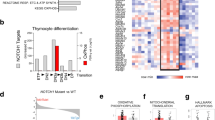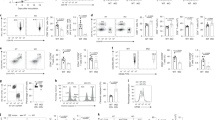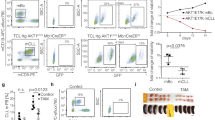Abstract
Interleukin-7 (IL-7) activates phosphoinositide 3-kinase/Akt/mammalian target of rapamycin (PI3K/Akt/mTOR) pathway, thereby mediating viability, proliferation and growth of T-cell acute lymphoblastic leukemia (T-ALL) cells. Reactive oxygen species (ROS) can be upregulated by growth factors and are known to regulate proliferation and viability. Here, we show that IL-7 upregulates ROS in T-ALL cells in a manner that is dependent on PI3K/Akt/mTOR pathway activity and that relies on both NADPH oxidase and mitochondrial respiratory chain. Conversely, IL-7-induced activation of PI3K signaling pathway requires mitochondrial respiration and ROS. We have previously shown that IL-7-mediated activation of PI3K pathway drives the upregulation of the glucose transporter Glut1, promoting glucose uptake in T-ALL cells. Using phloretin to inhibit Glut function, we demonstrate that glucose uptake is mandatory for ROS upregulation in IL-7-treated T-ALL cells, suggesting that IL-7 stimulation leads to increased ROS via PI3K pathway activation and consequent upregulation of Glut1 and glucose uptake. Overall, our data reveal the existence of a critical crosstalk between PI3K/Akt signaling pathway and ROS that is essential for IL-7-mediated T-ALL cell survival, and that may constitute a novel target for therapeutic intervention.
This is a preview of subscription content, access via your institution
Access options
Subscribe to this journal
Receive 12 print issues and online access
$259.00 per year
only $21.58 per issue
Buy this article
- Purchase on Springer Link
- Instant access to full article PDF
Prices may be subject to local taxes which are calculated during checkout




Similar content being viewed by others
References
Barata JT, Cardoso AA, Boussiotis VA . Interleukin-7 in T-cell acute lymphoblastic leukemia: an extrinsic factor supporting leukemogenesis? Leuk Lymphoma 2005; 46: 483–495.
Touw I, Pouwels K, van Agthoven T, van Gurp R, Budel L, Hoogerbrugge H et al. Interleukin-7 is a growth factor of precursor B and T acute lymphoblastic leukemia. Blood 1990; 75: 2097–2101.
Barata JT, Cardoso AA, Nadler LM, Boussiotis VA . Interleukin-7 promotes survival and cell cycle progression of T-cell acute lymphoblastic leukemia cells by down-regulating the cyclin-dependent kinase inhibitor p27(kip1). Blood 2001; 98: 1524–1531.
Scupoli MT, Vinante F, Krampera M, Vincenzi C, Nadali G, Zampieri F et al. Thymic epithelial cells promote survival of human T-cell acute lymphoblastic leukemia blasts: the role of interleukin-7. Haematologica 2003; 88: 1229–1237.
Barata JT, Silva A, Brandao JG, Nadler LM, Cardoso AA, Boussiotis VA . Activation of PI3K is indispensable for interleukin 7-mediated viability, proliferation, glucose use, and growth of T cell acute lymphoblastic leukemia cells. J Exp Med 2004; 200: 659–669.
Rich BE, Campos-Torres J, Tepper RI, Moreadith RW, Leder P . Cutaneous lymphoproliferation and lymphomas in interleukin 7 transgenic mice. J Exp Med 1993; 177: 305–316.
Abraham N, Ma MC, Snow JW, Miners MJ, Herndier BG, Goldsmith MA . Haploinsufficiency identifies STAT5 as a modifier of IL-7-induced lymphomas. Oncogene 2005; 24: 5252–5257.
Kim JH, Chu SC, Gramlich JL, Pride YB, Babendreier E, Chauhan D et al. Activation of the PI3K/mTOR pathway by BCR-ABL contributes to increased production of reactive oxygen species. Blood 2005; 105: 1717–1723.
Tamburini J, Elie C, Bardet V, Chapuis N, Park S, Broet P et al. Constitutive phosphoinositide 3-kinase/Akt activation represents a favorable prognostic factor in de novo acute myelogenous leukemia patients. Blood 2007; 110: 1025–1028.
Silva A, Yunes JA, Cardoso BA, Martins LR, Jotta PY, Abecasis M et al. PTEN posttranslational inactivation and hyperactivation of the PI3K/Akt pathway sustain primary T cell leukemia viability. J Clin Invest 2008; 118: 3762–3774.
Clerkin JS, Naughton R, Quiney C, Cotter TG . Mechanisms of ROS modulated cell survival during carcinogenesis. Cancer Lett 2008; 266: 30–36.
Xu D, Rovira II, Finkel T . Oxidants painting the cysteine chapel: redox regulation of PTPs. Dev Cell 2002; 2: 251–252.
Sundaresan M, Yu ZX, Ferrans VJ, Irani K, Finkel T . Requirement for generation of H2O2 for platelet-derived growth factor signal transduction. Science 1995; 270: 296–299.
Sattler M, Winkler T, Verma S, Byrne CH, Shrikhande G, Salgia R et al. Hematopoietic growth factors signal through the formation of reactive oxygen species. Blood 1999; 93: 2928–2935.
Lee SR, Yang KS, Kwon J, Lee C, Jeong W, Rhee SG . Reversible inactivation of the tumor suppressor PTEN by H2O2. J Biol Chem 2002; 277: 20336–20342.
Leslie NR, Bennett D, Lindsay YE, Stewart H, Gray A, Downes CP . Redox regulation of PI 3-kinase signalling via inactivation of PTEN. EMBO J 2003; 22: 5501–5510.
Lim S, Clement MV . Phosphorylation of the survival kinase Akt by superoxide is dependent on an ascorbate-reversible oxidation of PTEN. Free Radic Biol Med 2007; 42: 1178–1192.
Barata JT, Boussiotis VA, Yunes JA, Ferrando AA, Moreau LA, Veiga JP et al. IL-7-dependent human leukemia T-cell line as a valuable tool for drug discovery in T-ALL. Blood 2004; 103: 1891–1900.
Antunes F, Cadenas E, Brunk UT . Apoptosis induced by exposure to a low steady-state concentration of H2O2 is a consequence of lysosomal rupture. Biochem J 2001; 356: 549–555.
Devadas S, Zaritskaya L, Rhee SG, Oberley L, Williams MS . Discrete generation of superoxide and hydrogen peroxide by T cell receptor stimulation: selective regulation of mitogen-activated protein kinase activation and fas ligand expression. J Exp Med 2002; 195: 59–70.
Silva A, Jotta PY, Silveira AB, Ribeiro D, Brandalise SR, Yunes JA et al. Regulation of PTEN by CK2 and Notch1 in primary T-cell acute lymphoblastic leukemia: rationale for combined use of CK2- and gamma-secretase inhibitors. Haematologica 2010; 95: 674–678.
Waris G, Ahsan H . Reactive oxygen species: role in the development of cancer and various chronic conditions. J Carcinog 2006; 5: 14.
Guyton KZ, Liu Y, Gorospe M, Xu Q, Holbrook NJ . Activation of mitogen-activated protein kinase by H2O2. Role in cell survival following oxidant injury. J Biol Chem 1996; 271: 4138–4142.
Zhao M, Antunes F, Eaton JW, Brunk UT . Lysosomal enzymes promote mitochondrial oxidant production, cytochrome c release and apoptosis. Eur J Biochem 2003; 270: 3778–3786.
Sharma P, Chakraborty R, Wang L, Min B, Tremblay ML, Kawahara T et al. Redox regulation of interleukin-4 signaling. Immunity 2008; 29: 551–564.
Woo HA, Yim SH, Shin DH, Kang D, Yu DY, Rhee SG . Inactivation of peroxiredoxin I by phosphorylation allows localized H(2)O(2) accumulation for cell signaling. Cell 2010; 140: 517–528.
Wieman HL, Wofford JA, Rathmell JC . Cytokine stimulation promotes glucose uptake via phosphatidylinositol-3 kinase/Akt regulation of Glut1 activity and trafficking. Mol Biol Cell 2007; 18: 1437–1446.
Suh YA, Arnold RS, Lassegue B, Shi J, Xu X, Sorescu D et al. Cell transformation by the superoxide-generating oxidase Mox1. Nature 1999; 401: 79–82.
Hildeman DA . Regulation of T-cell apoptosis by reactive oxygen species. Free Radic Biol Med 2004; 36: 1496–1504.
Stone JR, Yang S . Hydrogen peroxide: a signaling messenger. Antioxid Redox Signal 2006; 8: 243–270.
Meng TC, Fukada T, Tonks NK . Reversible oxidation and inactivation of protein tyrosine phosphatases in vivo. Mol Cell 2002; 9: 387–399.
Kwon J, Lee SR, Yang KS, Ahn Y, Kim YJ, Stadtman ER et al. Reversible oxidation and inactivation of the tumor suppressor PTEN in cells stimulated with peptide growth factors. Proc Natl Acad Sci USA 2004; 101: 16419–16424.
Seo JH, Ahn Y, Lee SR, Yeol Yeo C, Chung Hur K . The major target of the endogenously generated reactive oxygen species in response to insulin stimulation is phosphatase and tensin homolog and not phosphoinositide-3 kinase (PI-3 kinase) in the PI-3 kinase/Akt pathway. Mol Biol Cell 2005; 16: 348–357.
Ellson C, Davidson K, Anderson K, Stephens LR, Hawkins PT . PtdIns3P binding to the PX domain of p40phox is a physiological signal in NADPH oxidase activation. EMBO J 2006; 25: 4468–4478.
Yamamori T, Inanami O, Nagahata H, Kuwabara M . Phosphoinositide 3-kinase regulates the phosphorylation of NADPH oxidase component p47(phox) by controlling cPKC/PKCdelta but not Akt. Biochem Biophys Res Commun 2004; 316: 720–730.
Baumer AT, Ten Freyhaus H, Sauer H, Wartenberg M, Kappert K, Schnabel P et al. Phosphatidylinositol 3-kinase-dependent membrane recruitment of Rac-1 and p47phox is critical for alpha-platelet-derived growth factor receptor-induced production of reactive oxygen species. J Biol Chem 2008; 283: 7864–7876.
Kakkar P, Singh BK . Mitochondria: a hub of redox activities and cellular distress control. Mol Cell Biochem 2007; 305: 235–253.
Desouki MM, Kulawiec M, Bansal S, Das GM, Singh KK . Cross talk between mitochondria and superoxide generating NADPH oxidase in breast and ovarian tumors. Cancer Biol Ther 2005; 4: 1367–1373.
Lee SB, Bae IH, Bae YS, Um HD . Link between mitochondria and NADPH oxidase 1 isozyme for the sustained production of reactive oxygen species and cell death. J Biol Chem 2006; 281: 36228–36235.
Wosniak Jr J, Santos CX, Kowaltowski AJ, Laurindo FR . Cross-talk between mitochondria and NADPH oxidase: effects of mild mitochondrial dysfunction on angiotensin II-mediated increase in Nox isoform expression and activity in vascular smooth muscle cells. Antioxid Redox Signal 2009; 11: 1265–1278.
Rathmell JC, Vander Heiden MG, Harris MH, Frauwirth KA, Thompson CB . In the absence of extrinsic signals, nutrient utilization by lymphocytes is insufficient to maintain either cell size or viability. Mol Cell 2000; 6: 683–692.
Tothova Z, Kollipara R, Huntly BJ, Lee BH, Castrillon DH, Cullen DE et al. FoxOs are critical mediators of hematopoietic stem cell resistance to physiologic oxidative stress. Cell 2007; 128: 325–339.
Kops GJ, Dansen TB, Polderman PE, Saarloos I, Wirtz KW, Coffer PJ et al. Forkhead transcription factor FOXO3a protects quiescent cells from oxidative stress. Nature 2002; 419: 316–321.
Venkatesan B, Mahimainathan L, Das F, Ghosh-Choudhury N, Ghosh Choudhury G . Downregulation of catalase by reactive oxygen species via PI 3 kinase/Akt signaling in mesangial cells. J Cell Physiol 2007; 211: 457–467.
Acknowledgements
We thank the contribution of patients and their families, and Dr Mário Chagas and all the physicians and nurses at the Pediatric Service of Instituto Português de Oncologia de Lisboa, in generously providing primary samples. This work was supported by grants from Associação Portuguesa Contra a Leucemia, and Fundação para a Ciência e a Tecnologia-FCT (PTDC/SAU-OBD/104816). AS and AG had PhD and postdoc fellowships from FCT, respectively.
Author information
Authors and Affiliations
Corresponding author
Ethics declarations
Competing interests
The authors declare no conflict of interest.
Additional information
Supplementary Information accompanies the paper on the Leukemia website
Rights and permissions
About this article
Cite this article
Silva, A., Gírio, A., Cebola, I. et al. Intracellular reactive oxygen species are essential for PI3K/Akt/mTOR-dependent IL-7-mediated viability of T-cell acute lymphoblastic leukemia cells. Leukemia 25, 960–967 (2011). https://doi.org/10.1038/leu.2011.56
Received:
Revised:
Accepted:
Published:
Issue Date:
DOI: https://doi.org/10.1038/leu.2011.56



